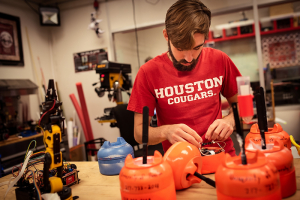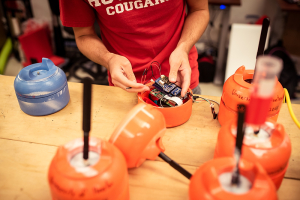Researchers share video of their Advanced Naval Technology Exercise
Discretion is an integral part of covert reconnaissance missions. With that in mind, a team of UH Cullen College of Engineering researchers are working on a $1 million project to create self-guided biodegradable containers of sensors to map coastlines and the bottom of the ocean.
Imagine a swarm of water bottle-sized devices stealthily floating on the waves gathering information along coastlines and then quietly dissolving once the mission is completed before reaching the shoreline. In addition to military reconnaissance, these devices could potentially be used for law enforcement and environmental monitoring.
The UH project is led by Craig Glennie, associate professor of civil engineering and an investigator with the National Center for Airborne Laser Mapping, or NCALM. Other Cullen College researchers involved are Megan Robertson, associate professor of chemical and biomolecular engineering, and Aaron Becker, assistant professor of electrical and computer engineering.
These innovative environmentally safe devices are now a step closer to reality.
Becker and his research assistants, along with Robertson and Glennie recently spent three days testing prototypes in Gulfport, Mississippi, with the Commander U.S. Naval Meteorology and Oceangraphy Commands (CNMOC), which oversees the Navy’s physical battlespace. They deployed three UH-made sensor nodes or drift nodes – each equipped with a camera, sonar, accelerometers, GPS, cellular connectivity and more. Once released, the nodes wirelessly sent measurements to a website during a five-hour exercise.
The team also participated in Industry Day, an event held by the Department of Defense, to present plans for current and future procurements to industry representatives. They did live demos of the biodegradable process for the packaging materials and the electronics included.
“Deploying the sensor nodes on the Navy’s fast boat was a treat,” Becker said. “We learned a lot about ocean-proofing our sensor nodes, and the industry teams shared some insight into electronics packages they use.”
The next step, after verifying that the sensor package works, the team will focus on integrating the biodegradable package and electronics into a unified device and then return for more testing.
Glennie, whose work with NCALM involves mapping with lasers and unmanned aerial vehicles, is responsible for the mapping capabilities. Robertson, who creates biodegradable plastics and other materials in her lab, is generating the materials for the devices. Becker, who works in swarm robotics and artificial intelligence, is focusing on deploying the sensors and working on a related project to develop a system to control a swarm of up to one million drones or other aerial reconnaissance vehicles in a way that appears to be unpredictable, thwarting an opponent’s ability to track and target them.
The UH project is part of a larger effort, funded by Office of Naval Research and led by Northeastern University.
Here is the video shared by the team: https://youtu.be/hmi50M-0nMw

